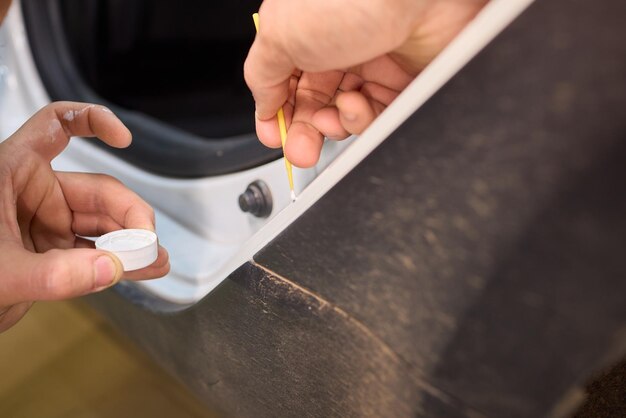Masterful Hacks for Repairing a Dent in Your Stainless Steel Fridge
Is there anything more disheartening than discovering an unsightly dent on your sleek, stainless steel refrigerator? While these blemishes might seem off-putting, you don’t have to live with them. With a bit of know-how and some DIY ingenuity, you can restore your fridge to its former glory. Here’s a comprehensive guide on tackling those troublesome dents without calling in the professionals.
Understanding the Nature of Stainless Steel Dents
What Causes Dents in Stainless Steel?
Stainless steel appliances, appreciated for their modern aesthetic and durability, aren't immune to dents. These can occur due to:
- Accidental bumps: From clumsy moments in the kitchen.
- Moving mishaps: During home moves or renovations.
- Daily use: More common in high-traffic areas of your kitchen.
Why Stainless Steel?
Stainless steel is prized for its corrosion resistance and aesthetic appeal. However, it’s softer than some might expect, making it susceptible to impact damages despite its resilience to rust and staining.
DIY Dent Repair Methods
1. Heat and Cold Technique
A clever use of temperature manipulation, this method takes advantage of the expansion and contraction properties of metal.
- Tools Required: Hairdryer or heat gun, and a can of compressed air.
- Procedure:
- Heat the Dent: Use a hairdryer to apply direct heat to the dented area for 30 seconds to one minute to the point where it’s warm but not too hot.
- Apply Cold Air: Immediately spray compressed air upside down (to emit cold air) onto the heated area. The rapid temperature change can cause the dent to pop out.
2. The Suction Cup Method
A tried-and-true technique often used for car dents, this method employs the natural vacuum created by suction cups.
- Tools Required: A small plunger or a specifically designed dent puller.
- Procedure:
- Create a Seal: Moisten the edge of the suction cup, place it over the dent, and ensure a firm seal.
- Pull the Dent Out: With even pressure, pull the suction cup outwards. Sometimes, gentle tapping around the dent with a soft mallet can aid the process.
3. Using a Wooden Block and Hammer
This method relies on a more hands-on, precise approach. It involves leveraging physical force applied strategically.
- Tools Required: A flat-ended piece of wood (like a dowel), a hammer, and a piece of cloth.
- Procedure:
- Protect the Surface: Place a piece of cloth over the dent to avoid scratches.
- Tap Out the Dent: Position the wood on the dent and gently tap it with the hammer from behind, applying pressure gradually to avoid creating new dents.
4. The Hot Water Technique
- Tools Required: Kettle or a pot of hot water.
- Procedure:
- Pour Hot Water: Over the dented area of the fridge door.
- Quickly Apply Compressed Air: This combination can work similarly to the heat and cold method by quickly expanding and contracting the metal.
Pros and Cons: DIY Methods
| Pros | Cons |
|---|---|
| Cost-effective | Requires some dexterity |
| Convenient and quick | May not work for all dents |
| No professional help | Risk of scratch/paint damage |
Professional Repair Options
When to Call a Professional
If the dent is particularly large or deep, professional intervention might be necessary. Professionals employ tools like dolly sets and hammers, providing precise fixes without risking surface damage.
What to Expect
- Cost Estimation: Slightly more than DIY methods but often includes warranties.
- Duration: Quick turnaround, ensuring the convenience of your appliance remains unaffected.
- Quality Assurance: Guaranteed expertise with a polished finish.
🎯 Quick Tips and Key Takeaways
- Choose your method based on the size and location of the dent.
- Patience is crucial: Gentle and gradual techniques yield the best results.
- Safety first: Protective gloves and eyewear can prevent accidents.
- Preserve your finish: Always use a soft cloth to avoid scratching.
🔧 Handy Maintenance Tips
- Positioning: Keep space around your refrigerator to minimize accidental bumps.
- Regular Checks: Inspect for dents periodically to attend to them promptly.
- Educate family members: Awareness helps in reducing accidental knocks.
Preventative Measures: Keeping Your Fridge Dent-Free
Optimal Placement and Use
- Strategic Positioning: Place your fridge against a wall or in a less-trafficked part of the kitchen.
- Mindful Activity: Train children and remind adults to be cautious around kitchen appliances.
Regular Maintenance
- Cleaning Routine: Use gentle, non-abrasive cloths and cleaning agents. Regular cleaning keeps your fridge looking new and allows for early detection of any blemishes.
Final Words of Wisdom
Consider investing in protective gear like corner guards for your fridge if you frequently move it or have an active household. These covers can help absorb shock and prevent future dents. Though dents in a stainless steel refrigerator can sully its appearance, they’re not the end of the world. With the right approach, a dent-free fridge and a beautifully seamless kitchen can be yours once again.
